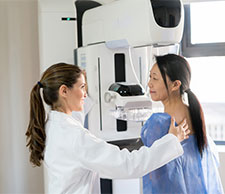Breast Cancer Prevention
Learn About Breast Cancer Screening
The best way to prevent breast cancer is to make sure you are following the recommendations of your doctor for routine breast cancer screening.
A 3-Step Plan for Breast Cancer Prevention
Breast self-exams, clinical breast exams, and mammograms make up the 3-step plan for breast cancer prevention. Finding breast cancer early is the primary goal of the plan because it gives you the best chance for successful treatment. Routine breast cancer screening can also help find other noncancerous or benign conditions, too.
Step 1. Breast Self-Exam (BSE)
This is when a woman feels her breasts for lumps. There is some debate among health professionals about the effectiveness of this breast cancer screening measure because evidence suggests BSEs do not lower the risk of dying from breast cancer. However, the American Cancer Society (ACS) says all women should get to know how their breasts typically look and feel so changes can be detected.
See your health care provider right away if you recognize:
- A lump
- Leaky fluid, or discharge, other than breastmilk
- Swelling
- Skin irritation or dimpling
- Nipple problems (for example, pain, redness, flaking, or inverting)
Step 2. Clinical Breast Exam (CBE)
Your yearly physical exam should include a clinical breast exam by a physician or nurse trained to check for breast problems. A CBE exam is done very much like a BSE. If you do regular BSEs, be sure to ask questions and talk about any concerns with your provider during your CBE.
The American College of Obstetricians and Gynecologists recommends the following as breast cancer screening guidelines:
- Women between the ages of 29 to 39 have a CBE by a health professional every 1 to 3 years.
- Women who are older than 40 have a breast exam by a health care professional every year.
Talk with your health care provider about your risk factors and the appropriateness of a CBE during your visit. That will help you and your doctor decide if you should have a CBE.
Step 3. Mammogram
Both the National Cancer Institute and the ACS recommend that women who may be at higher risk for breast cancer talk with their health care providers about beginning yearly mammogram at an earlier age.
The Importance of a Mammogram

A mammogram is a low-dose X-ray of your breasts, and it is the most common
imaging test for breast cancer screening. A mammogram can find cancer
or other problems early before a lump can be felt or other early signs
of breast cancer are present. This allows a diagnosis in the earliest
stages of the disease.
Early detection results in better outcomes. Based on recent data, average survival rates at five years for women diagnosed with breast cancer are 91 percent for localized disease and 85 percent for regional disease.
Health experts have different breast cancer screening guidelines for mammograms:
- The American Cancer Society (ACS) recommends yearly screening for all women ages 45 to 54.
- Women 40 to 44 have the option to start screening with a mammogram each year.
- Women ages 55 and older can switch to a mammogram every other year, or they can choose to continue with yearly mammograms. Screening should continue if they have a health history that supports such a decision.
- The U.S. Preventative Services Task Force recommends screening every two years for women ages 50 to 74.
Discuss personal risk factors with your health care provider. The conversation will help you and your doctor decide when to start getting mammograms, and how often to have them.
Wondering if a yearly mammogram is right for you? Find an RWJBarnabas Health physician or breast center.
Why Choose Us for Breast Cancer Care?
RWJBarnabas Health, in partnership with Rutgers Cancer Institute, the state’s only NCI-designated Comprehensive Cancer Center, meets the highest standards in breast cancer research, treatment, prevention and education in the country.
To schedule an appointment with one of New Jersey’s best breast cancer specialists call 844-CANCERNJ or 844-226-2376.




